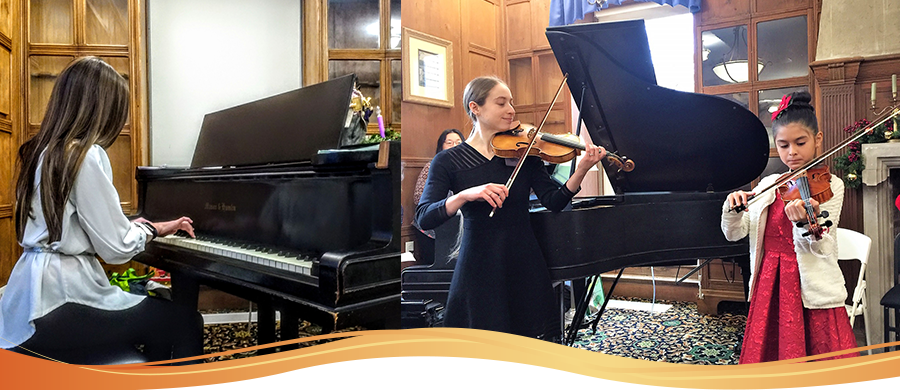
Online
Music for the Community
If you're interested in a particular category, you can sort performances by student age, instrument, singalong music, composer and so on - click on the orange tags under the text. We hope you and your family will enjoy watching our students share their music!
To have each week's videos and accompanying info sent to your inbox*, please subscribe via the orange button.
*Videos are delivered twice weekly; you can unsubscribe at any time, and we will never share or sell your info.
Subscribe to this Page
Displaying items by tag: Bach
Day 55 - Bach Concerto for Two Violins
Violinists age 12 and 16 play Bach Concerto in D minor for Two Violins, second movement
The beloved "Bach Double", one of the composer's most famous works, is usually recognized by its fast first movement. Here, though, we're featuring the lyrical second movement with its expansive, lilting melody. The two violinists have equal parts that weave in and out of each other in a soulful musical conversation in the flowery Baroque style, taking turns with the melody and the accompaniment, finally coming to rest together.
Bach probably wrote this concerto when he was "Kapellmeister" - Director of Music - at the court Prince Leopold of Anhalt-Cothen between 1717 and 1723. This was a very happy employment situation for Bach - Prince Leopold, who was a musician himself, appreciated Bach's talents, paid him well, and gave him a lot of freedom to compose and perform whatever suited him. Much of the music of Bach that we've shown in this series comes from this time, including the orchestral suites and cello suites, as well as his music based on 18th century dances (here, here, and here).
Day 49 - Bach Prelude from Suite in G
Violist age 14 and Cellist age 16 play Bach Prelude in G major
Because of their musical and technical difficulty, the Suites were not much performed until the great 20th century cellist Pablo Casals took them up, after discovering them in a thrift shop in Barcelona, Spain at the age of 13. His famous recordings of them were selected in 2019 for preservation in the Library of Congress.
Day 38: Bourrée 1 & 2 by Bach
Cellist age 16 plays Bourrées I & II from Bach Solo Suite #3 in C
More old-fashioned dance music today, but unlike a Minuet, a Bourrée (pronounced "boo-ray") is in duple time (ONE two, ONE two) – similar to a Gavotte. Still, like our Minuet and Trio on Day 36, this set of two Bourrées is again made on an overall A B A pattern.
Day 16: Gavotte from Bach's Orchestral Suite in D
Violist age 11 plays "Gavotte" from Orchestral Suite in D by Bach
Bach wrote four Orchestral Suites. They all have an opening piece called an Overture, followed by a collections of movements (individual pieces) based on the dance forms of the time. These suites were very popular in Bach's day, and could be considered the “easy listening” music of the mid-18th century.
This is the third movement of Bach's third suite of this type, written about 1730 and arranged here for viola. The term Gavotte for a lively dance originated in the 1690s from Provence in southern France. The Old Provençal word gavoto (mountaineer's dance) comes from gavot, a local name for an Alpine resident, which is said to mean literally "boor" or "glutton"! You can hear that this rather heavy-footed dance might well suit a country bumpkin....
Day 9: Courante, Bach Suite #3 in C
Violist age 16 plays “Courante” from Bach Suite #3 for Viola/Cello
A viola is more than just a “big violin”. That extra size gives it a deeper, darker sound. Bigger things vibrate more slowly - try filling a smaller glass and a bigger glass with water, and tapping them each with a fork, and you’ll hear that idea at its most basic.
The viola has the same tuning as the cello, except an octave higher (meaning the viola’s strings vibrate exactly twice as fast as a cello’s) - so they can share some of the same music, including Bach’s solo suites. “Suite” means a collection of pieces which go together, and Bach’s suites are collections of 18th century dance music. “Courante” literally means “running”, and you can hear how this piece just keeps going and going – try running around to it!
If you like the sound of the viola, it’s a great instrument to learn to play – there are never enough viola players, and you will get lots of invitations to play with others!
Day 7: Minuet in C by Bach
Cellist age 11 plays Bach’s Minuet in C
A minuet is an elegant 18th century dance – think ladies in dresses with huge ruffled skirts, and gentlemen in knee britches. This dance in 3/4 time, with small, elegant steps and many bows and curtsies, was all the rage in the fancy ballrooms of Europe (especially France and England) from about 1650 to 1750. Since Bach lived from 1685-1750, this was basically the pop music of his time. See if you can feel the 1, 2, 3, 1, 2, 3 pulse, then get our your dress-up stuff and dance to the 18th century beat!
Day 1: "Musette" by Bach
Violinist age 9 plays "Musette" by Bach
Johann Sebastian Bach lived from 1685 to 1750. He was born in what is now Germany, was the youngest of 8 children, and had a thorough musical education from his father, uncles and older brother.
He was a very hardworking musician who lived and worked at the courts of various dukes and princes, where he had to produce new music on a weekly basis for courtly events and chapel services. Not surprisingly, his published works number well over 1000, and it's thought that there were many more which have been lost over time.
His main performing instrument was the organ, but he wrote pieces for many other instruments, including voice. He wrote this Musette originally for harpsichord, a forerunner of the modern-day piano. A "Musette" was actually a kind of bagpipe popular at the time, and Bach was trying to imitate one here - if you listen carefully to the piano accompanying the violin, you may be able to hear the held bass note or "pedal tone", just as you would with a bagpipe.


